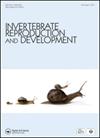Molecular cloning, characterization and expression profiles of a SoxB2 gene related to gonadal development in mud crab (Scylla paramamosain)
IF 0.8
4区 生物学
Q4 REPRODUCTIVE BIOLOGY
引用次数: 6
Abstract
ABSTRACT The molecular mechanisms underlying sex differentiation and gonad development remain elusive in crustaceans. Here, we report the cloning and characterization of a Sry-related high-mobility group family B2 gene (SpSoxB2) from an economic crustacean species, the mud crab Scylla paramamosain. The SpSoxB2 encodes a putative HMG-box protein (317 amino acids) clustered with invertebrate Sox14 homologues in the SoxB2 subgroup, but shared low similarity with SpSox14. SpSoxB2 was expressed in the hepatopancreas, thoracic ganglion, and gonads (relatively higher expression in testis than ovary). In hepatopancreas, SpSoxB2 expression was not significantly affected by sex or gonadal development stages. In testis, it was demonstrated that the SpSoxB2 expression level increased from Stage I to Stage III and then decreased afterwards. During ovarian development, the SpSoxB2 expression level continually increased from Stage I to Stage V. Furthermore, fluorescence in-situ hybridization showed that SpSoxB2 transcripts were present in both somatic and developing germ cells in the gonads. In testis, SpSoxB2 transcripts were strongly localized in spermatocytes and spermatids. In ovary, SpSoxB2 transcripts were detected in follicle cells, oogonia and oocytes, with the strongest signal in follicle cells. Our results demonstrated that the SpSoxB2 gene may play an important role during gonadal development in mud crab.泥蟹性腺发育相关基因SoxB2的克隆、表征及表达谱分析
甲壳类动物性别分化和性腺发育的分子机制尚不清楚。本文报道了一种经济甲壳动物Scylla paramamosain的sy相关高迁移族B2基因(SpSoxB2)的克隆和特征。SpSoxB2编码一个推测的HMG-box蛋白(317个氨基酸),与SoxB2亚群中的无脊椎Sox14同源物聚集在一起,但与SpSox14的相似性较低。SpSoxB2在肝胰脏、胸神经节和性腺中表达(睾丸中的表达相对高于卵巢)。在肝胰腺中,SpSoxB2的表达不受性别和性腺发育阶段的显著影响。在睾丸中,SpSoxB2的表达水平在ⅰ期至ⅲ期呈上升趋势,随后呈下降趋势。在卵巢发育过程中,SpSoxB2的表达水平从ⅰ期持续上升到ⅴ期。荧光原位杂交显示,SpSoxB2转录本在性腺的体细胞和发育性生殖细胞中均存在。在睾丸中,SpSoxB2转录本强烈定位于精母细胞和精母细胞。在卵巢中,在卵泡细胞、卵原细胞和卵母细胞中均检测到SpSoxB2转录本,其中在卵泡细胞中信号最强。结果表明,SpSoxB2基因可能在泥蟹性腺发育过程中起重要作用。
本文章由计算机程序翻译,如有差异,请以英文原文为准。
求助全文
约1分钟内获得全文
求助全文
来源期刊
CiteScore
1.90
自引率
0.00%
发文量
21
审稿时长
>12 weeks
期刊介绍:
Invertebrate Reproduction & Development ( IRD) presents original research on the reproductive and developmental biology of the Invertebrata, both embryonic and postembryonic. IRD welcomes papers reporting significant results obtained using new techniques. Encouraged topic areas include: aquaculture, physiology, biochemistry, functional morphology, phylogeny, behavioural and regulatory mechanisms, including genetic, endocrine and molecular studies. Papers containing qualitative descriptions of reproductive cycles and gametogenesis will not be considered. IRD is published in association with the International Society of Invertebrate Reproduction and Development.

 求助内容:
求助内容: 应助结果提醒方式:
应助结果提醒方式:


